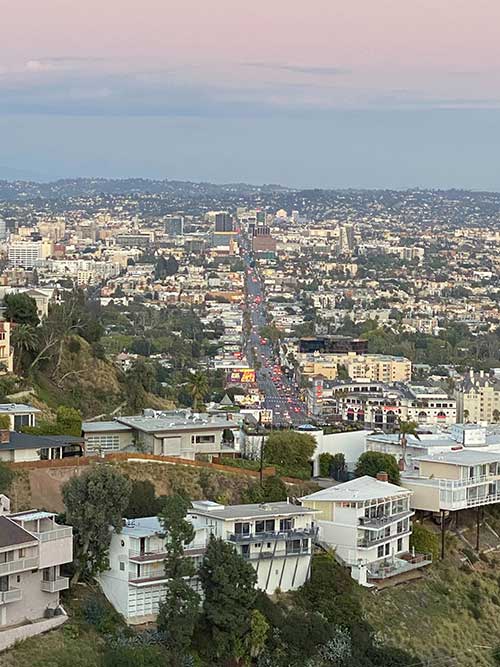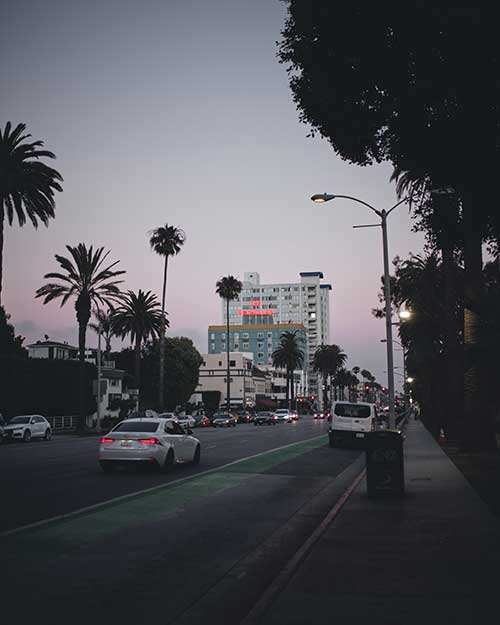Our Hollywood tours drive on some very noteworthy and historic streets. Some of the busiest streets in Hollywood, CA are:
- Hollywood Boulevard: This is one of the most famous streets in Hollywood, known for its Walk of Fame, the TCL Chinese Theatre, and many other tourist attractions.
- Sunset Boulevard: This iconic street runs from downtown Los Angeles through Hollywood and Beverly Hills and is known for its nightlife, trendy restaurants, and upscale boutiques.
- Vine Street: This street intersects with Hollywood Boulevard and is home to the Capitol Records Building, the Pantages Theatre, and many restaurants and shops.
- Highland Avenue: This street is known for its historic landmarks such as the Hollywood Bowl and the Dolby Theatre, as well as numerous shopping and dining options.
- Cahuenga Boulevard: This street runs through the heart of Hollywood and is known for its nightlife, including bars, clubs, and music venues.
- Santa Monica Boulevard: While not technically in Hollywood, this street runs through West Hollywood and is known for its lively atmosphere, including many bars, restaurants, and shops.
Sunset Blvd.

Art deco building on Sunset Blvd.
Sunset Boulevard has a rich and interesting history in Hollywood. Here are some key events and developments that shaped its evolution:
- Early Days: Sunset Boulevard was first developed in the late 19th century as a dirt road that connected downtown Los Angeles to the ocean. It was used primarily by farmers and ranchers who transported their goods to market.
- Hollywood Development: In the early 20th century, Hollywood began to develop as a center of the movie industry. Many movie studios, including Paramount and Warner Bros., were located along Sunset Boulevard.
- Rise of the Automobile: With the advent of the automobile in the 1920s, Sunset Boulevard became a major thoroughfare for commuters and tourists. It was widened and paved to accommodate the growing traffic.
- Nightlife and Entertainment: In the 1930s and 1940s, Sunset Boulevard became known for its vibrant nightlife and entertainment scene. It was home to many nightclubs, restaurants, and theaters, including the legendary Whisky a Go Go and the Troubadour.
- Counterculture and Protest: In the 1960s and 1970s, Sunset Boulevard became a hub of counterculture and protest movements. It was the site of many demonstrations against the Vietnam War and other political issues.
- Renewal and Revitalization: In recent years, Sunset Boulevard has undergone a period of renewal and revitalization. Many of its historic buildings have been restored, and new developments have brought in trendy restaurants, hotels, and shops.
Today, Sunset Boulevard remains a cultural and commercial hub of Los Angeles, attracting millions of visitors each year.

Aerial view of Sunset Blvd. leading to Hollywood
Our Famous Vine Street

Art deco building on Sunset Blvd.
Vine Street has a long and storied history in Hollywood, California. Here are some key events and developments that shaped its evolution:
- Early Development: Vine Street was originally developed in the late 19th century as a residential street for middle-class families. It was named after the vineyards that once occupied the area.
- Hollywood Development: In the early 20th century, Hollywood began to develop as a center of the movie industry. Many movie studios, including Columbia Pictures, were located along Vine Street.
- Hollywood Walk of Fame: In the 1950s, the Hollywood Chamber of Commerce created the Hollywood Walk of Fame, which features stars embedded in the sidewalk along Vine Street and other nearby streets. The first star, for actress Joanne Woodward, was installed in 1960.
- Music and Entertainment: In the 1960s and 1970s, Vine Street became a hub of music and entertainment. Many famous music venues, including the Whisky a Go Go and the Roxy Theatre, were located on or near Vine Street.
Today, Vine Street remains an important cultural and commercial hub of Hollywood, attracting tourists and locals alike. It is also home to many of the city’s historic landmarks, including the Capitol Records Building and the Pantages Theatre.
Cahuenga Boulevard’s Storied Past
Cahuenga Boulevard is a major thoroughfare in Hollywood, California. Here are some key facts and notable features of Cahuenga Boulevard:
- Location: Cahuenga Boulevard runs north-south through the heart of Hollywood, connecting the Hollywood Hills to the Hollywood Freeway.
- History: Cahuenga Boulevard was originally a Native American trail that was later used by Spanish explorers and settlers. In the early 20th century, it became a major route for commuters and tourists, connecting downtown Los Angeles to the Hollywood Hills.
- Nightlife: Cahuenga Boulevard has long been known for its vibrant nightlife scene, with many bars, clubs, and music venues. It is home to many popular spots, such as the Hotel Café, the Blue Whale, and the Sayers Club.
- Landmarks: Cahuenga Boulevard is also home to several historic landmarks, such as the Hollywood Bowl and the Ford Theatres. The Crossroads of the World shopping center, which was built in 1936 and designed to look like a giant globe, is also located on Cahuenga Boulevard.
- Restaurants and Shops: Cahuenga Boulevard is lined with many restaurants and shops, offering a diverse range of cuisine and products. The boulevard is also known for its street art and murals.
- Transit: Cahuenga Boulevard is served by several bus lines, making it easily accessible by public transit. It is also located near several subway and light rail stations.
Overall, Cahuenga Boulevard is a lively and diverse street that offers something for everyone. Its rich history, cultural landmarks, and vibrant nightlife make it a must-visit destination in Hollywood.

Cars on Santa Monica Blvd. near Hollywood, CA.